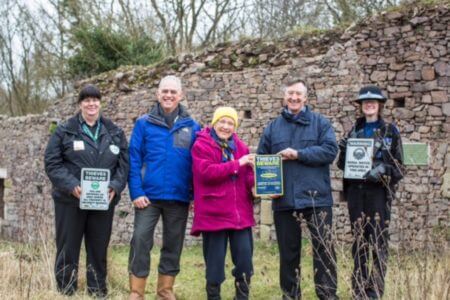
At Hartshill Castle are North Warwickshire Rural Crime Co-coordinator Carol Cotterill; Ian George, Inspector of Ancient Monuments for Historic England; Miss Jean Lapworth, custodian of the castle; Phil Cleary, Co Founder and Director of Smartwater and PCSO Sarah Fretter.
The remains of an historic Motte and Bailey castle near Nuneaton have been given extra protection from criminals thanks to modern forensic property marking technology.
The castle was originally built in 1125 by Hugh de Hardreshull, but it became unused when Robert de Hartshill was killed in the Battle of Evesham in 1265, before being rebuilt by John de Hardreshull in 1330. The remains of a Motte and Bailey Castle still exist, but it is on Historic England’s at risk register and the owner has set up a trust to look after it.
In recent months PCSO Sarah Fretter from Warwickshire Police and Carol Cotterill, Rural Crime Coordinator for North Warwickshire, have been working with the custodians of the castle to improve security, after receiving reports people were stealing stones from the ruins.
The team were approached by a representative of the SmartWater Foundation, who offered to help create a deterrent by marking the stones with a unique SmartWater solution, enabling them to prove the provenance and bring a prosecution against the thieves should any further stones be stolen.
Reading University’s Department of Archaeology carried out tests to ensure the SmartWater would not damage the stones, allowing Historic England to give its approval for its unusual use.
Inspector David Williams from Warwickshire Police said “We are always looking at new and innovative ways to prevent crime and catch those responsible for committing crime. The remains of Hartshill Castle are for everyone to enjoy and we are sending out a strong message to anyone thinking of taking the stones in future that we are looking for you and if we recover them we will be able to link them back to the castle and take appropriate action.”
Phil Cleary, Co-Founder and Director of the SmartWater Foundation said, “Our new charitable work in helping protect sites of historic importance throughout the world continues and although we don’t have unlimited resources, we’re happy to be able to make this donation of our technology and services to protect Hartshill Castle.”
Ian George, Inspector of Ancient Monuments for Historic England, said: “The gradual erosion of these historic sites due to the activity of thieves and vandals is highly regrettable and we will do all we can to protect such sites. In this case we are very grateful to the SmartWater Foundation for their offer of help to improve the security of this nationally important castle site.”
Miss Jean Lapworth, settler of the Harold Lapworth Charitable Trust which owns the castle, added: “I am extremely grateful to the Smartwater Foundation for their generosity and interest in helping us preserve the remains of the castle. The castle, which is in the centre of Hartshill, is valued by the community and I am sure the residents will join me in expressing their gratitude to everyone who has helped us in putting measures in place to help protect the site.”
The Rural Crime Project is funded by Warwickshire Police and Crime Commissioner to help rural communities across the county to protect themselves from crime. Three Rural Crime Co-ordinators work with Police Safer Neighbourhood Teams to help local residents, businesses and sites of historic importance to boost their security.
